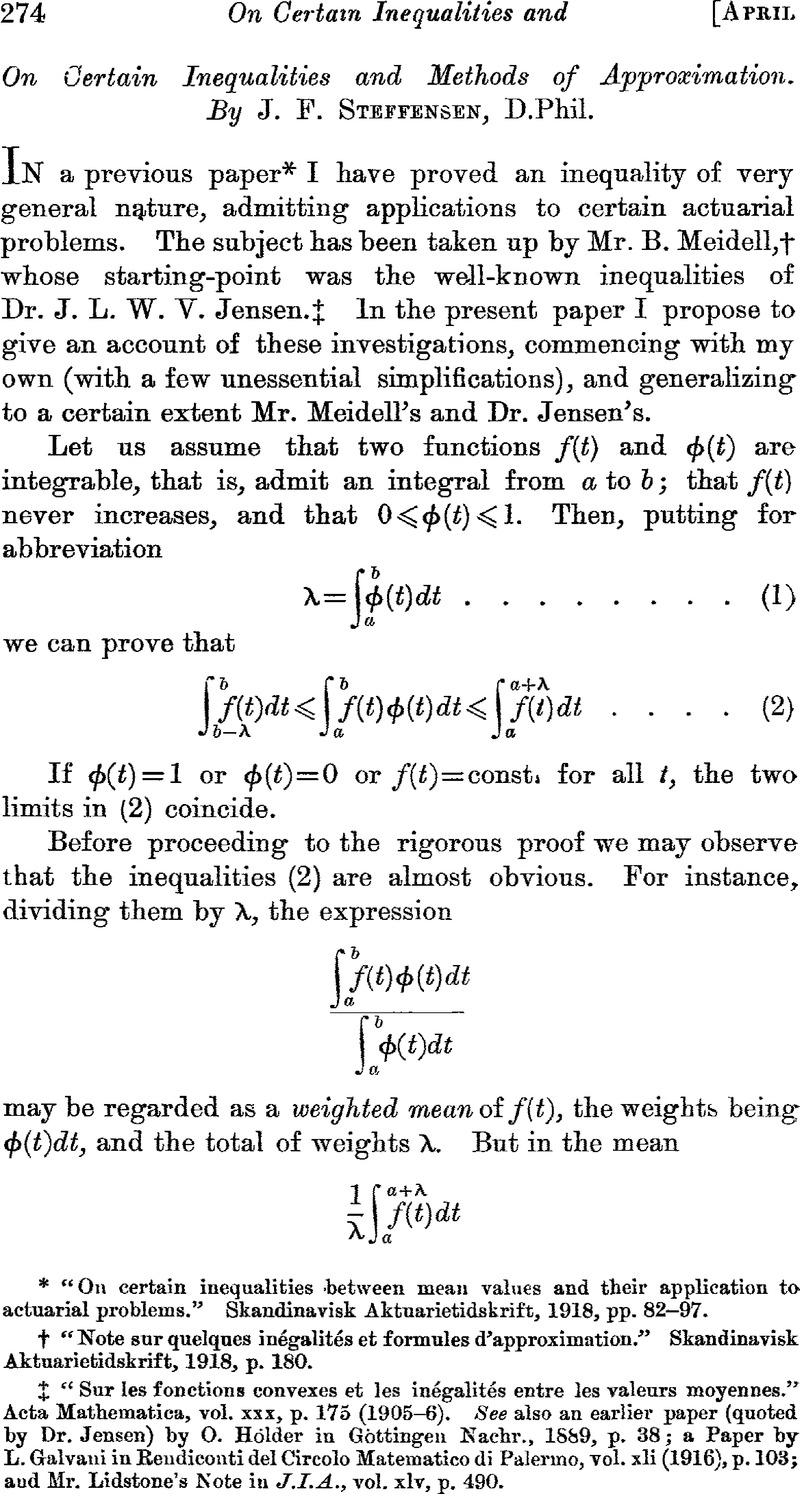Published online by Cambridge University Press: 18 August 2016

page 274 note * “On certain inequalities between mean values and their application to actuarial problems.” Skandinavisk Aktnarietidskrift, 1918, pp. 82–97.
page 274 note † “Note sur quelques inégalités et formules d'approximation,” Skandinavisk Aktuarietidskrift, 1918, p. 180.
page 274 note ‡ “Sur les fonctions convexes et les inégalités entre les valeurs moyennes.” Acta Mathematica, vol. xxx, p. 175 (1905-1906)Google Scholar. See also an earlier paper (quoted by Dr. Jensen) by O. Holder in Gottingen Nachr., 1889, p. 38; a Paper by Gralvani, L. in Rendiconti del Circolo Matematico di Palermo, vol. xli (1916), p. 103 CrossRefGoogle Scholar; aud Mr. Lidstone, 's Note in J.I. A., vol. xlv, p. 490.Google Scholar
page 277 note * Bromwich, : An Introduction to the Theory of Infinite Series. London, 1908. P. 54 and p. 426.Google Scholar
page 277 note † We may evidently write (2) in the form
where a≤θ≤b−λ
page 277 note ‡ Text-Book, Part II, 1st Edit., p. 112.
page 278 note *
The reason for this is, that we shall have ![]() provided that either δ=0, or else μx = 0 for all values of x.
provided that either δ=0, or else μx = 0 for all values of x.
page 280 note * This standard deviation, has, of course, nothing to do with the standard deviation examined by Bremiker and others, in the estimated value of an annuity on a single life. The latter concerns the application, the former the origin of the table.
page 280 note † G. P. Hardy: The Theory of the Construction of Tables of Mortality, &c., p. 99.
page 281 note * Thiele: “Theory of Observations,” p 39.
page 284 note * Compare Galvani, l.c. Dr. Jensen uses as criterion
and proves his theorem by generalizing this inequality.
page 284 note † With regard to this notion (which goes back to Newton), see a Note in this Journal by L. Oppermann, vol. xv, p. 145.
page 284 note ‡ That is: for all arguments for which the function is assumed to exist.
page 286 note * Formula (30) is independent of the assumed properties of f(n) and e(n). This formula is, in fact, the analogon for sums of Dirichlet's formula for integrals.
page 287 note * The characteristic geometrical quality of convexity, easily deducible from (24), is that the straight line connecting any two points of the curve leaves the part of the curve situated between these two points, below it. This may be proved as follows: Writing yn for for ψ(xn), and, assuming x1<x2<x3, (24) may be written
whence
Now, the equation to the straight line between (x1, y1) and (x3, y3) is
putting, here, x=x2 we see at once that y≥y2.
Vice versâ, (24) follows from the geometrical characteristic. This characteristic quality is also at once proved by the criterion ψ”(x)≤0 which is, therefore, equivalent to (24), whenever ψ”(x) exists.
page 289 note * The formula derived by Mr. Meidell is the particular case obtained by putting g(t)=t in (36); he assumes, like Dr. Jensen, that k(t) is positive, and introduces certain restrictions, necessary for the manipulation of the integrals. These restrictions are avoided by operating, as we have done in establishing (32), on sums instead of integrals. The process, by which (32) was generalized into (35), would, in the case of Mr. Meidell's formula, correspond to substituting another variable in the integral.
page 289 note † Putting, in (38), br= kr we have (apart from the notation) inequality (A) in Mr. Lidstone's paper In J.I.A., vol. xlv, p. 487.Google Scholar
page 290 note * For cr = 1 (39) shows that the arithmetical mean of positive quantities is never smaller than the geometrical mean.
page 290 note † See Mr. Lidstone's paper “On the Equation of Payments, &c,” J.I.A., vol. xlv, p. 484 Google Scholar. The more general inequality on the same page is obtained by putting, in (35), ψ(t) = tm, xr = r, cr = Sr.
page 291 note * One or two minor errors in the last figure have been corrected.
page 293 note *
Example : ω=2, ![]() .
.
page 295 note * J.I.A., vol. xlV, p. 483.
page 297 note * Compare a paper by Meidell, Mr. on the theory of limitation of risk in Transactions of the Seventh Actuarial Congress, vol. i, p. 88.Google Scholar